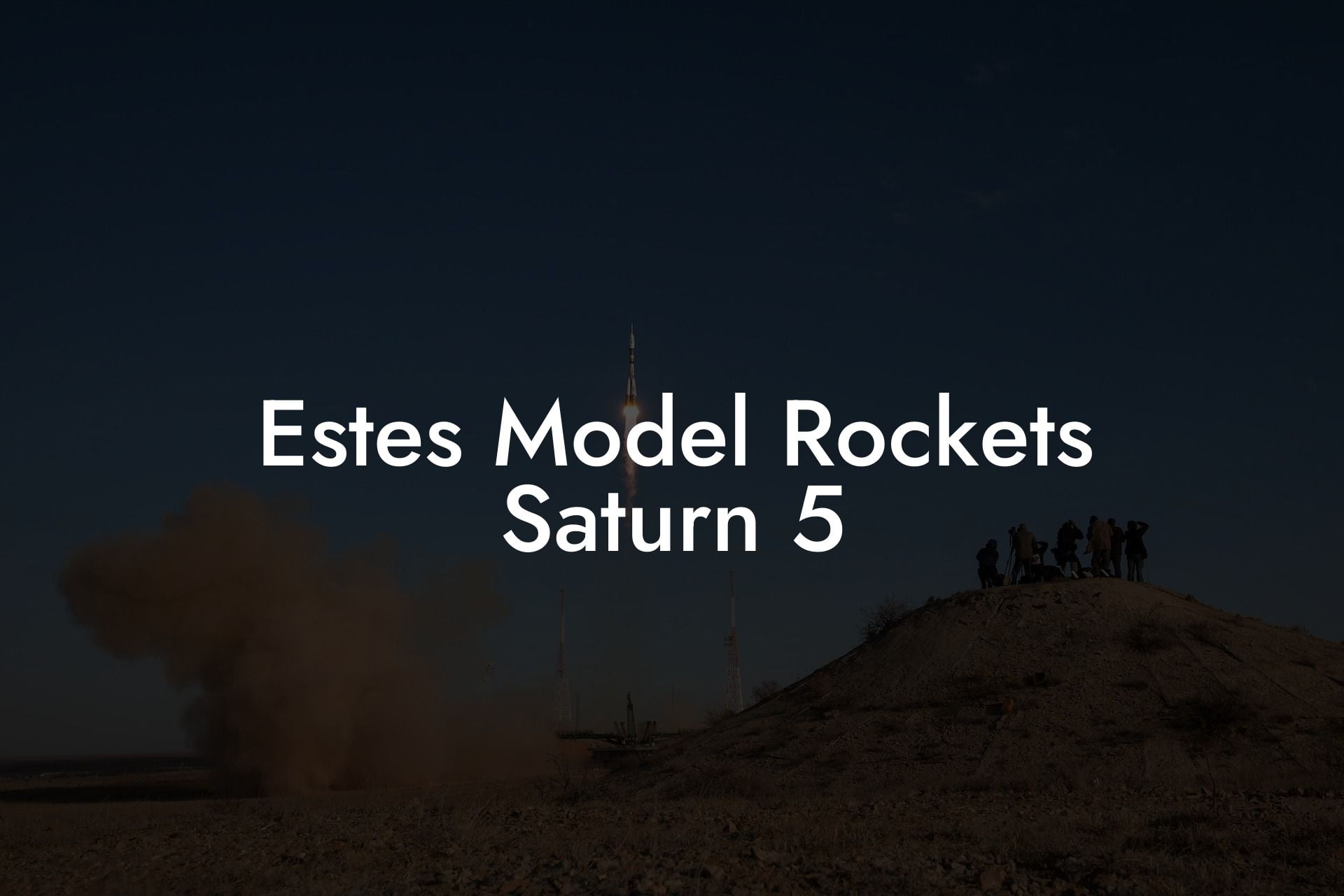Imagine blasting off into the world of model rockets, where the thrill of launch day meets the excitement of exploration. Welcome to the Estes Model Rockets Saturn 5, a legendary kit that's been fueling imaginations and inspiring innovation for generations. Whether you're a seasoned rocketeer or just starting your model rocket journey, this comprehensive guide will walk you through the fascinating history, impressive features, and expert tips for getting the most out of your Estes Saturn 5 experience.
Quick Links to Useful Sections
- A Brief History of the Estes Saturn 5
- Impressive Features of the Estes Saturn 5
- Expert Tips for Building and Flying Your Estes Saturn 5
- Building Your Estes Saturn 5
- Flying Your Estes Saturn 5
- Recovery and Maintenance
- Resources and community Support: Your Next Steps
- Frequently Asked Questions: Your Estes Saturn 5 Questions Answered
A Brief History of the Estes Saturn 5
The Estes Saturn 5 is a 1/200th scale replica of the iconic NASA Apollo Saturn V rocket, which successfully landed astronauts on the moon in 1969. First introduced in the 1960s, the Estes Saturn 5 model rocket kit has become a beloved classic, cherished by model rocket enthusiasts worldwide for its stunning accuracy, impressive size, and reliable performance.
Over the years, the Estes Saturn 5 has undergone several design updates, ensuring that this legendary kit remains a cutting-edge choice for model rocket enthusiasts. From its durable, precision-molded plastic parts to its high-quality, detailed decals, every aspect of the Estes Saturn 5 is designed to deliver an unforgettable building and flying experience.
Impressive Features of the Estes Saturn 5
So, what makes the Estes Saturn 5 so special? Here are just a few of the impressive features that set this model rocket kit apart:
- Scale accuracy: The Estes Saturn 5 is a meticulously detailed, 1/200th scale replica of the NASA Apollo Saturn V rocket, ensuring an unparalleled level of authenticity.
- Large size: Standing over 36 inches tall, the Estes Saturn 5 is an imposing model rocket that's sure to turn heads at any launch event.
- Durable construction: The kit's precision-molded plastic parts are designed to withstand the rigors of launch and recovery, ensuring a long lifespan for your model rocket.
- High-quality decals: The Estes Saturn 5 features beautifully detailed, authentic decals that perfectly capture the spirit of the original NASA Apollo Saturn V rocket.
- Easy to assemble: Despite its impressive size and complexity, the Estes Saturn 5 is designed to be easy to assemble, even for beginners.
Whether you're a seasoned model rocket enthusiast or just starting out, the Estes Saturn 5 offers an unbeatable combination of scale accuracy, impressive size, and durable construction.
Looking For The Best Model Rocket Kits? You'll Love These:
Expert Tips for Building and Flying Your Estes Saturn 5
To get the most out of your Estes Saturn 5 experience, follow these expert tips from seasoned model rocket enthusiasts:
Building Your Estes Saturn 5
When building your Estes Saturn 5, make sure to follow the instructions carefully, taking your time to ensure each component is properly aligned and securely attached. Use a high-quality adhesive, such as cyanoacrylate (CA) glue, to ensure a strong bond between parts.
Flying Your Estes Saturn 5
Before flying your Estes Saturn 5, always check the weather conditions, ensuring a safe and successful launch. Choose a wide, open area with minimal obstacles, and make sure to follow all safety guidelines and local regulations.
Recovery and Maintenance
After each flight, carefully inspect your Estes Saturn 5 for any signs of damage or wear. Perform routine maintenance tasks, such as cleaning and lubricating moving parts, to ensure your model rocket remains in top condition.
Resources and community Support: Your Next Steps
As you embark on your Estes Saturn 5 journey, remember that you're part of a vibrant community of model rocket enthusiasts. Here are some valuable resources to help you get the most out of your experience:
- Estes Model Rockets: Visit the official Estes website for a wealth of information on the Saturn 5, including instructions, FAQs, and customer support.
- National Association of Rocketry (NAR): Join the NAR to connect with fellow model rocket enthusiasts, access exclusive resources, and stay up-to-date on the latest developments in the hobby.
- Online Forums and Communities: Participate in online forums and social media groups dedicated to model rockets, where you can share tips, ask questions, and showcase your Estes Saturn 5 creations.
By tapping into these resources and connecting with like-minded enthusiasts, you'll be well on your way to unlocking the full potential of your Estes Saturn 5 model rocket kit.
Frequently Asked Questions: Your Estes Saturn 5 Questions Answered
Here are some frequently asked questions about the Estes Saturn 5, along with expert answers to help you get started:
1. What is the recommended age range for the Estes Saturn 5?
The Estes Saturn 5 is recommended for model rocket enthusiasts aged 10 and above, with adult supervision required for younger builders.
2. How long does it take to build the Estes Saturn 5?
The build time for the Estes Saturn 5 can vary depending on your level of experience and the amount of time you can dedicate to the project. On average, expect to spend around 10-20 hours building your model rocket.
3. What type of motor is recommended for the Estes Saturn 5?
The Estes Saturn 5 is designed to accommodate a range of motors, including the Estes C11 and D12 engines. Always follow the manufacturer's recommendations and safety guidelines when selecting a motor for your model rocket.
4. Can I customize my Estes Saturn 5?
Yes! The Estes Saturn 5 is a highly customizable model rocket kit, allowing you to add your own personal touches and creative flair. From custom paint schemes to advanced electronics, the possibilities are endless.
Looking For The Best Model Rocket Kits? You'll Love These:
Useful Interruption: Dive deeper into the world of Model Rockets with our most popular sections. If there is anything you think is missing or anything you would love for us to write about, just give us a shout.
- Getting Started & Basics With Model Rockets
- Model Rocket Design, Build & Customization
- Model Rocket Propulsion & Engine Technology
- Model Rocket Launch Techniques & Recovery
- Model Rocket Advanced Rocketry & Innovations
- Model Rocket DIY and Customization
- Model Rocket Equipment Reviews & Digital Tools
- Community, Competitions & Education
- Model Rocket Troubleshooting & FAQs
- Model Rocket Bonus/Seasonal & Niche Topics
A group of model rocket enthusiasts gathered at a field for their weekly launch event. Among them was Dave, a seasoned builder known for pushing the limits of hobby rocketry. This time, he had outdone himself.
“Ladies and gentlemen,” Dave announced, dramatically pulling a cloth off his latest creation, “I present to you: The Kraken!”
The crowd gasped. This wasn’t just a model rocket, it was a monster. The thing stood 8 feet tall, had six clustered engines, and was covered in enough duct tape to qualify as a classified aerospace project.
“Dave,” muttered Steve, the cautious safety officer, “Have you, uh… done the math on this?”
“Math?” Dave scoffed. “I built it in my garage at 3 a.m. with parts from eBay. This is an art piece, Steve.”
The countdown began.
5…
4…
3…
2…
1…
The engines ignited with a BOOM, and The Kraken shot up… kind of. It immediately did a violent barrel roll, narrowly missing the spectators before skyrocketing at an angle that could only be described as “legally questionable.”
The crowd collectively ducked as The Kraken flew straight over the adjacent cornfield, where Old Man Jenkins, the grumpiest farmer in town, was minding his business.
KABOOM!
The rocket disappeared behind the barn. A moment later, a flaming piece of Estes igniter wire landed at Steve’s feet. The silence was deafening.
And then, an unmistakable sound echoed across the field.
Jenkins’ shotgun being cocked.
“DAVE!!!” Steve shouted. “RUN.”
And that was the day Dave invented the first-ever biologically powered rocket booster: pure adrenaline.
To this day, nobody knows where The Kraken landed, but legend has it, it still haunts the skies, terrifying unsuspecting drones and low-flying birds.















